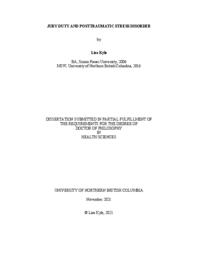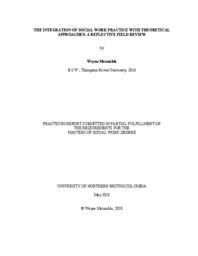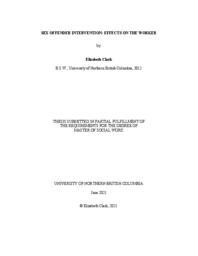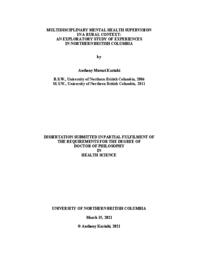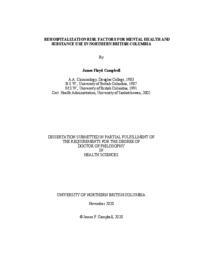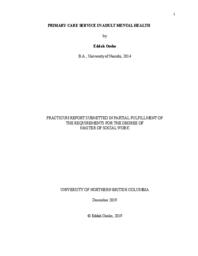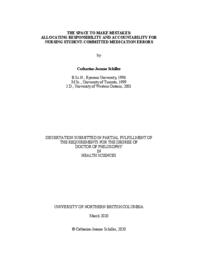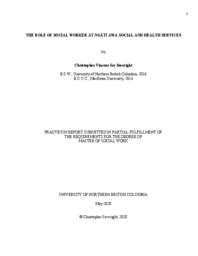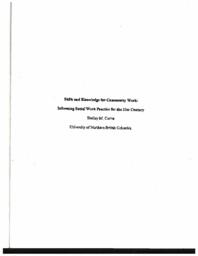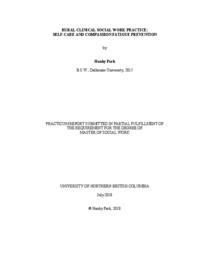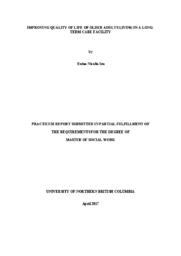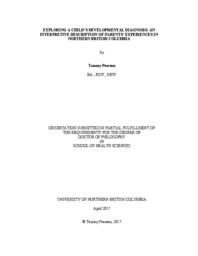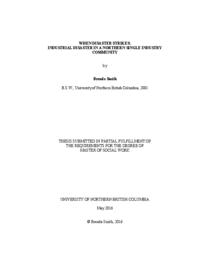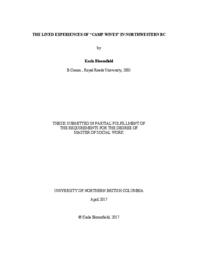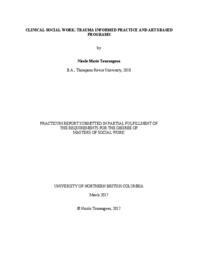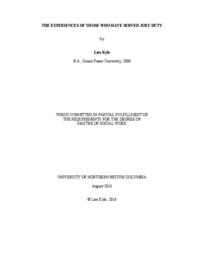Schmidt, Glen
Person Preferred Name
Glen Schmidt
Related Works
Content type
Digital Document
Origin Information
Content type
Digital Document
Origin Information
Content type
Digital Document
Description / Synopsis
Equine assisted therapies are growing in popularity as a modality for treating various mental health and developmental challenges. Many of these challenges require focused work on the development of empathy, perspective taking, and attunement to self and others. This study examines the participants’ experiences and understanding of empathy as it relates to self, humans, and equine partners via structured qualitative interviews with four therapy participants. The interviews conducted for this study demonstrated a distinct common understanding of empathy as the ability to take perspective based on the human’s or animal’s own orientation in the world; an understanding that developing empathy within the context of equine therapy was emotionally laborious and required significant work and emotional engagement on the participant’s behalf. The interviews indicated that the participants’ perceived the horse as emotionally neutral in therapeutic interactions. Furthermore, the study indicated that a central component to the perceived success of this modality of therapy was a parallel process in relationship between the facilitator/client dyad and the client/equine dyad.
Origin Information
Content type
Digital Document
Description / Synopsis
Research on jurors and juror symptomatology has been conducted for many years; however, existing research has primarily been completed in the United States. What little research was conducted in Canada is now several years ago. Further, there is sufficient anecdotal evidence to suggest PTSD can and does occur as a result of serving jury duty. As such, this research sought to explore the relationship between jury duty participation and PTSD symptomology, as described by participants. This research is qualitative and involved two stages. First, participants (n=14) were asked to complete an online demographic survey that included a self-report measure for PTSD, the PCL-5. Second, participants (n=12) were invited to complete a one-two hour interview. Findings from the interviews were analyzed via thematic analysis. This research found three participants who met the criteria for probable PTSD (when using a cut-off score of 32). Overall, jurors in Canada echo previous research that states sources of symptoms relate to viewing disturbing images, deliberations, sequestering, and fear of making a mistake. New insight indicates fear associated with retaliation may be a major contributing factor for symptomology. Further, jurors whose life experiences relate to the trial type may be a contributing factor for symptomology. Policy and practice recommendations include improving information for jurors before they begin their service and providing more consistent follow-up support for jurors. Research should continue to explore the relationship between jurors and symptomology.
Origin Information
Content type
Digital Document
Description / Synopsis
This practicum report is an integration of self-reflection, current literature, research, theory, and knowledge, based on my Master of Social Work field practicum with the Youth services Team at Carrier Sekani Family Services located in Prince George, British Columbia. This report focuses on the significance of systemic, social, economic, and cultural barriers and the ongoing consequences these obstacles have on the life outcomes for Indigenous youth aging out of care. This report identifies the population currently accessing services at Carrier Sekani Family Services and provides statistical evidence to highlight the significance of this social phenomenon. Furthermore the integration of social work practice with theoretical approaches combined with academic literature relevant to my practicum placement is discussed. Finally, the report concludes with a discussion on relevant learning experiences and the implications certain events can have on personal and professional development.
Origin Information
Content type
Digital Document
Description / Synopsis
This paper describes a qualitative study involving six participants who work in the field of sex offender intervention. Participants’ struggles and professional rewards are examined. Recommendations on workplace policy and procedure adjustments are made based on the findings. Although participants identified rewards of their work, they described many physical, emotional, and mental health struggles they encountered, because of their employment. They also identified supports that promoted their wellbeing in the work.
Origin Information
Content type
Digital Document
Description / Synopsis
The purpose of this study was to better understand how multidisciplinary mental health supervision might work in rural remote settings. There is a need for supervisory approaches that address the unique contextual challenges in rural and remote multidisciplinary service delivery, such as management approaches, isolation, and lack of support. This study focused on three areas linked to multidisciplinary mental health supervision: challenges and opportunities, role perception, and differences in approaches. This study also attempted to reconcile the core supervisory requirements with the contextual challenges. The few studies on rural remote supervision have primarily focused on general internal and external factors facing rural remote professionals. Despite its importance, knowledge of how multidisciplinary rural remote supervisors perceive and/or appreciate their roles is limited. This study was informed by social construction and symbolic interaction theories, and guided by three research questions: 1) What challenges and opportunities do mental health supervisors experience in northern British Columbia? 2) How do frontline workers, supervisors, and senior managers perceive the roles and activities of mental health supervisors in northern British Columbia? 3) How are supervisory approaches in various mental health disciplines different or similar in northern British Columbia? The research methodology was qualitative and the study design adopted an interpretive, social interactionist approach. Source triangulation enhanced both the credibility and transferability of the findings. The sources included three participant groups: frontline mental health workers, mental health supervisors, and senior mental health managers. Another triangulation source was the context and setting review of BC’s complex mental health jurisdictions. Triangulation was also achieved by interviewing participants who worked in different settings, organizations, and geographic locations. Thematic analysis was used for data analysis resulting in 11 manifest themes and the following five latent themes: Difficult, overwhelming responsibilities; stressful, complicated decision making; the endless campaign for professional leadership support; mentorship in remote practice; and a struggle in collaborative plurality. Most of the participants expressed the wish for more support in their professional work. The findings from this study provide employers with new insights into multidisciplinary supervisory work and also emphasize the need for practical and specific ideas for much needed support for rural remote supervisors.
Origin Information
Content type
Digital Document
Description / Synopsis
Attention-deficit/hyperactivity disorder (ADHD) is a controversial diagnosis that is debated in public and professional spheres. However, the experiences of Aboriginal peoples have largely not been included in this debate. Considering that reactions to trauma may include hyperactivity and attention-deficits, and that mental health is defined differently in different cultures, this is arguably problematic. This research uses a qualitative exploratory approach embedded in an anti-oppressive social work research framework to explore the experiences of four urban Aboriginal mothers of children diagnosed with ADHD in Northern British Columbia. It was found that Aboriginal caregivers experience many challenges already recorded in the literature, and that they also grapple with the impacts of colonialism and intergenerational trauma in different ways. When considering the principles of allyship and anti-oppressive practice, this raises ethical questions about where the burden of responsibility lies, as well as how ADHD is currently defined and used in practice.
Origin Information
Content type
Digital Document
Description / Synopsis
This report chronicles a part-time 14 month field practicum at Canadian Mental Health Association, Regina Branch. The document provides an overview of Asset Based, Empowerment Approach and Change Theory within the Community Engagement program and how they were applied as an intervention to increase access to primary mental health. There is also a discussion about the variety of presentations that I attended and participated in throughout the field practicum. An outline is provided about the professional development opportunities that strengthened my practice. I also reflect on the ethical issues and challenges I faced during my field practicum. Throughout the document I discuss ways in which I was able to achieve my learning goals in the field practicum.
Origin Information
Content type
Digital Document
Description / Synopsis
Mental health and substance use (MH&SU) rehospitalization rates are used as indicators of treatment quality, to reduce costs, and measure efficacy. Research on this topic in rural Canadian hospitals and communities is lacking. This study used secondary data on 5159 patients (age 15 and older) hospitalized with International Classification of Disease (ICD) F code MH&SU diagnosis. These patients had 9103 admissions to 18 hospitals in Northern British Columbia during a five-year period, April 1st, 2010 through March 31st, 2015. ANOVA and Tukey Post Hoc tests were used to examine associations of two performance measures with five patient factors; community size, Indigenous culture, relationship status, employment status, and ICD F code diagnoses. The first measure was number of hospital readmissions. Of the 5159 patients with 9103 admissions, 3482 (67.6%) had one hospital admission during the five-year period. The remaining 1677 (32.4%) patients had 3944 (43.3%) of the hospitalizations). Patients whose cultural identity was Indigenous had over-representation and increased readmissions. Patients who were single and never in a relationship had increased hospitalizations. Patients whose ICD F coding for schizophrenia or psychosis had increased hospitalizations. The second measure was wait time for community MH&SU follow-up. Of the 5159 patients, 4512 (87.5%) had contact with community MH&SU during the five-years. Urban communities with specialized MH&SU services had reduced wait times for follow up. Patients whose cultural identity was Indigenous had longer wait times for community MH&SU follow-up. Patients who were divorced or separated had longer wait times. Patients with ICD F coding for schizophrenia or psychosis had shorter wait times for follow-up. The relationship between hospital readmission and community MH&SU follow-up was examined using logistic regression with the five factors. An inverse relationship was found between the two performance measures. Patients who did not have community MH&SU follow-up within 30 days had reduced odds ratio of readmissions, whereas patients who had follow-up within 30 days had increased odds ratio for readmissions. Although the study finds support for patient risk factors, evidence suggests approaches like a Decision Support Tool (DST) might provide reliability for intervention, and resource planning, as well as timely intervention.
Origin Information
Content type
Digital Document
Description / Synopsis
This practicum report describes my experience of working with adults who presented with mental health concerns at the Primary Care Interprofessional Team (PCIPT) at Northern Interior Health Unit, Prince George. Primary care is a relatively new model in health care that seeks to move away from the old practice where treatment of mental illness was mostly provided by the general practitioners. Primary health care relies on the contributions of team members to work collaboratively to address the different needs of the clients. The purpose of my practicum was to find out how clients benefit when different disciplines work together to improve their health outcome. This report described my learning goals and objectives and how they were met through observation, reflection, and practice. The practicum experience also enabled me to further develop my social work skills and have an understanding of how mental health problems affect individual wellbeing.
Origin Information
Content type
Digital Document
Description / Synopsis
A medication error committed by a student nurse during a clinical placement often results in the student fearing its potential impact on the patient, unit staff, and the student’s educational journey. Student nurses must navigate two parallel systems during a clinical placement – the educational system and the healthcare system – and there can be confusion about what each requires of the student. Neither of these systems contain clear direction for managing student-committed medication errors and for allocating associated responsibility and accountability. This exploratory mixed methods study examines the process by which responsibility and accountability for a student-committed medication error is allocated and the factors that influence that allocation decision. It describes key features of an ideal allocation process and suggests reasons why the current allocation process often does not meet those requirements. Qualitative data were analyzed through interpretive description and quantitative data were analyzed using descriptive statistics. The results were situated, interpreted, and triangulated within a critical realism philosophical framework. An ideal post-error environment must incorporate a just culture. Since students must navigate both the educational institution and the healthcare facility environments during a clinical placement, a just culture must permeate both. However, students are instead colliding with a post-error environment that they perceive as not meeting key ideals of a just culture: fairness, transparency, minimization of fear, and dedication to learning. Findings of this study can be used to drive change that will better support those who are involved in a post-error process, and decrease the significant inconsistencies that are currently of particular concern.
Origin Information
Content type
Digital Document
Description / Synopsis
The intention of this practicum report is to provide a further understanding of the social worker’s role at Ngāti Awa Social and Health Services in Whakatāne, New Zealand. Ngāti Awa Social and Health Services provided me with a unique learning opportunity to explore the importance of a Māori framework within their programs on a rotational basis such as: Iwi Social Services, Rangiatea (i.e. Teen Parent Unit), and Te Waipuna Ariki o Matangireia ECE (i.e. Early Child Education). This report will provide an emphasis and understanding of the importance of incorporating Māori culture, and teachings within their agency framework at Ngāti Awa Social and Health Services. This practicum was a unique venture to be included as part of the Cross-Cultural Indigenous Knowledge Exchange (CCIKE) program. The practicum was only possible with multiple organizations coming together to consult, collaborate, and communicate. The following organizations were involved: University of Northern British Columbia (UNBC), UNBC First Nations Department, Te Whare Wānanga o Awanuiārangi, UNBC Master of Social Work program, and Queen Elizabeth II Diamond Jubilee Scholarship. This practicum opportunity represented the first collaboration with the Master of Social Work program and the Māori organizations. This experience allowed me to set specific learning goals in the following areas: professional practice, education development, cultural competency, cross-cultural experience, the ability to challenge oneself (i.e. out of my own comfort zone), and be an active participant in cultural events. This report will include a detailed description of the agency, theoretical frameworks/model, observations, research, critical reflection, hands-on experience, and an understanding of how Māori integrated programming improves health outcomes for Māori Whānau.
Origin Information
Content type
Digital Document
Origin Information
Content type
Digital Document
Origin Information
Content type
Digital Document
Origin Information
Content type
Digital Document
Origin Information
Content type
Digital Document
Origin Information
Content type
Digital Document
Origin Information
Content type
Digital Document
Origin Information
Content type
Digital Document
Origin Information
Content type
Digital Document
Origin Information
Content type
Digital Document
Origin Information




